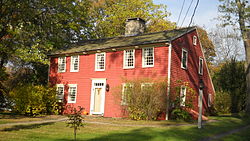Ephraim Hawley, son of Joseph Hawley (1603-1690), married Sarah Welles of Wethersfield, CT, and made his residence in Stratford, where he was a substantial and influential citizen, but was not in public office as much as his brothers Samuel and John. He was a farmer, having received abundance of land from his father, and lived probably in Stratford village. He left no will, but an inventory of his estate is dated 14 May, 1690.
The Hawley Record, compiled and published by Elias Sill Hawley, 1890
Genealogical Note #12, page 442
.png)
Ephraim Hawley Descendants
Ephraim was born on August 14, 1659 at Stratford. He was chosen as a fence viewer with Benjamin Beach on January 17, 1687.He was propounded as a freeman to the court of the Connecticut Colony at Hartford in May 1687 with his brother Captain John Hawley. To be elected a freeman in the Colony at this time, one had to own real property, a dwelling house, in his name.
Ephraim died on April 18, 1690 and the inventory of his estate was taken on May 14, 1690 and filed on June 12, 1690. Local legend is that he and his horse were killed by lightning, and since no grave has ever been found and the inventory of his estate did not include a horse, this may be true. Fairfield County raised an army on April 11, 1690 to defend Albany, New York following the Schenectady Massacre during King William’s War. Ephraim may have died during the trip there, from fighting or disease (small pox). His peer who served in the war, Lt. John Hubbell, died on May 1, 1690 at Wood Creek (Fort Ann) in New York and was buried at the spot where he died. Lt. Agur Tomlinson, Ensign of the army raised in Fairfield County, would later marry Ephraim Hawley’s widow Sara Welles on 19 October 1692.
The house lands and meadow were appraised at 352 pounds by the Fairfield County Probate Court. Since Ephraim died intestate, without a will, and according to English Law at the time, title to the dwelling house passed to the oldest living male heir, his half brother Robert. His widow’s dowry was returned to her out of her eldest son Daniel’s double portion of lands, which were sold, and she received all of the movable estate or personal property. The estate was not distributed until December 14, 1706.
Ephraim Hawley House is a Colonial American wooden post-and-beam timber-frame farm house located on the Farm Highway, Route 108, on the south side of Mischa Hill in the center of the village of Nichols in Trumbull, Connecticut in New England. Construction of the house began between 1670 and 1690. The house is unique, besides being the oldest house in Trumbull, it has been located in four different named townships in its long history, but has never been moved; Stratford (1670–1725), Unity (1725–1744), North Stratford (1744–1797) and Trumbull (1797–present).
The Hawley Homestead was dated to 1690 during the Works Progress Administration Federal Writers’ Project conducted during the Great Depression. Joan Oppenheim, completed a research report on the house while studying Architecture at Yale University. She concluded, after examining the structure, researching land records, probate records and the Hawley record, that the house was built between 1683 and 1690 by Farmer Ephraim Hawley who married Sarah Welles, granddaughter of Connecticut Colony Governor Thomas Welles in 1683.
The date of construction was not only based upon architectural details of the house, but also upon comparisons with other homes of the period, facts given to her by the Curtiss family, who owned the house at the time, and information from the Hawley Record which stated that Ephraim resided in Trumbull. Oppenheim also stated the dating of the house compared with that of S.S. on file at the School of Fine Arts at Yale.

The house was dated to 1671-1683 in the 2002 Historic and Architectural Resource Survey produced for the Connecticut Historical Commission by Geoffrey Rossano, PhD. The 2010 Historic and Architectural Survey of the Town of Trumbull, Connecticut produced by Heather C. Jones and Bruce G. Harvey PhD for the Connecticut Commission on Culture and Tourism, dates the house to 1670-1683. A piece of oak framing was carbon dated to 1710 with a standard deviation of 40 years.
Cape Cod Cottage
The house began as a 1 1?2-story Cape Cod cottage thirty-six feet wide by twenty-six feet deep with an eight-foot-wide central stone chimney with three fireplaces. There were four rooms downstairs, a small entryway, parlor and dining room in front and the kitchen in back. The second story was one undivided loft. Due to its modest size, the house was expanded several times.
The first expansion took place sometime in the late seventeenth century when a seven-foot-deep lean-to addition was added onto the northeast corner of the rear of the house which was used at first as a morning room and became the buttery (room) and pantry. The north exterior wall is made of two inch thick oak boards. When the lean-to was built, the roof was extended, without a break, to within six feet six inches of the ground and gave the house its saltbox shape. The original hand-riven oak clapboard exterior siding is preserved in the attic that was created.
The second expansion was completed sometime before the Civil War when a lean-to was added to the remaining rear of the house which reused the original poplar vertical feather-edge beaded paneling, that had encased the original stairs, as roof sheathing. The rear exterior oak clapboards were left in place preserved in the attic that was created. At the same time, the front roof was raised to a full story in height and new vertically-sawn two inch by ten inch common rafters were installed. The second floor was petitioned into five small bedrooms each with a closet. The batten doors were pine and the cast-iron hardware, hinges and latches were made by Eli Whitney Blake. A new central staircase was installed, since removed, up against the kitchen fireplace and a wall was built that divided the house into a two-family.
In 1840, Schaghticoke Truman Mauwee, or Truman Bradley, moved into the house as a tenant. In 1881, Bradley purchased the house from Charles Fairchild for $450 ($100 in cash and a $350 mortgage to Fairchild). A year later, Bradley sold the house to next door neighbor Clarissa Curtis for $525 ($175 cash and Curtiss assumed the $350 mortgage to Fairchild).
Oak Frame and Siding
The first growth white oak post-and-beam frame consists of eight by ten inch girts, eight by eight inch plates and eight by ten inch splayed posts. The rafters are eight by eight inches and taper to six by six inches and the floor joist are six by six inches and spaced twenty inches apart.
The six inch by ten inch summer beams run parallel to the front of the house and are dovetailed into the girts. They are located above the interior walls that divide the front rooms from the kitchen, however, they do not support any joist. Since the house was plastered when built, the summer beams were reduced in size and concealed within the plaster ceiling. According to some Connecticut Architectural historians, the introduction of plaster, as an interior finish, brought about the end to the tradition of using summer beams. The home builder, obviously holding onto traditional building methods of the time, included summer beams in the frame, but in a reduced size, as they were beginning to be phased out altogether in this part of the state. The roof sheathing and flooring is vertically quarter sawn one-inch-thick oak boards with random widths between twelve and thirty inches. The flooring is laid directly over one-inch-thick split oak boards. The mortise-and-tenon joints are held by wooden pins, and the flooring is nailed with large hand-wrought iron nails. The four- to six-foot-length hand-riven oak clapboard siding is nailed directly to the oak studs with large flat rose-headed nails which was the typical material and application for the earliest New England homes.
Stone Chimney
The first floor of the house was built at ground level with a very modest field stone foundation. There is a partial dirt cellar located on the south side of the house. The eight-foot-wide stone fireplace is squared up to the chimney girts. The three flues are laid up with clay on top of a ten-by-ten-foot stone foundation. The kitchen hearth is nine feet six inches wide by three feet three inches deep. There is a one-foot crawl space around the chimney foundation below the first floor. A forty inch deep brick beehive bake oven is built into the right rear wall of the kitchen fireplace and its small opening is spanned by a wrought iron lintel. The brick are seven and one-half inches long by three and one-half inches wide by two inches thick indicating they were made before brick dimensions were regulated in the Colony of Connecticut in 1685.
There is a small tinder box built into the left wall of the kitchen firebox. The fireplace inside dimensions are four feet four inches high by six feet ten inches wide and is spanned by the original ten-by-ten-inch oak lintel, which rests on oak beams. The side walls of the kitchen firebox are roughly dressed granite. Cooking pots were hung from a lug pole. Above the ridge, the chimney flue outside measurements are forty eight inches wide by thirty eight inches deep with a course of three inch thick stone drip caps in the front and back.
Interior Finish
The original front exterior door opened out and the stairs, closed in by vertical paneling, are located between the parlor and kitchen. The vertical feather-edge beaded poplar hardwood paneling alternate in width from thirteen inches and fifteen inches. The ceilings and walls are clam shell plaster on riven oak lath. Initially, there was no baseboard molding and the plaster finished flush to the flooring. The girts and posts were plastered over and not cased.
The ceiling heights are between six feet two inches and seven feet two inches on the first floor. The rear exterior door opening is five feet three inches high and originally opened out. An original casement window opening located on the east rear wall, in the kitchen, is twenty two inches square and is fifty four inches from the floor. This small opening was plastered over when the lean-to was built behind the wall in the 1840s. There is evidence that at one time shelving was installed in this opening.
The upstairs ceiling height is six feet. The surviving oak sash window frames have dimensions of twenty eight inches wide by forty six inches high, and also serve as studs for the clapboards and lath. The original interior doorways are twenty eight inches wide by five feet eleven inches high and the interior partitions are made of 1 1?2-inch-thick vertical oak boards.
Source: Wikipedia


